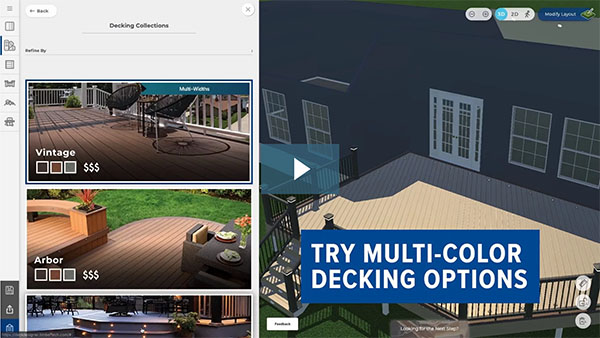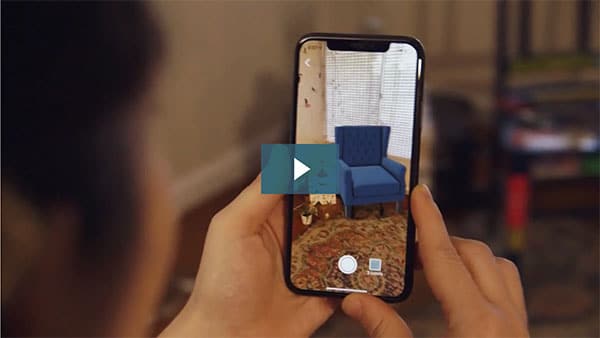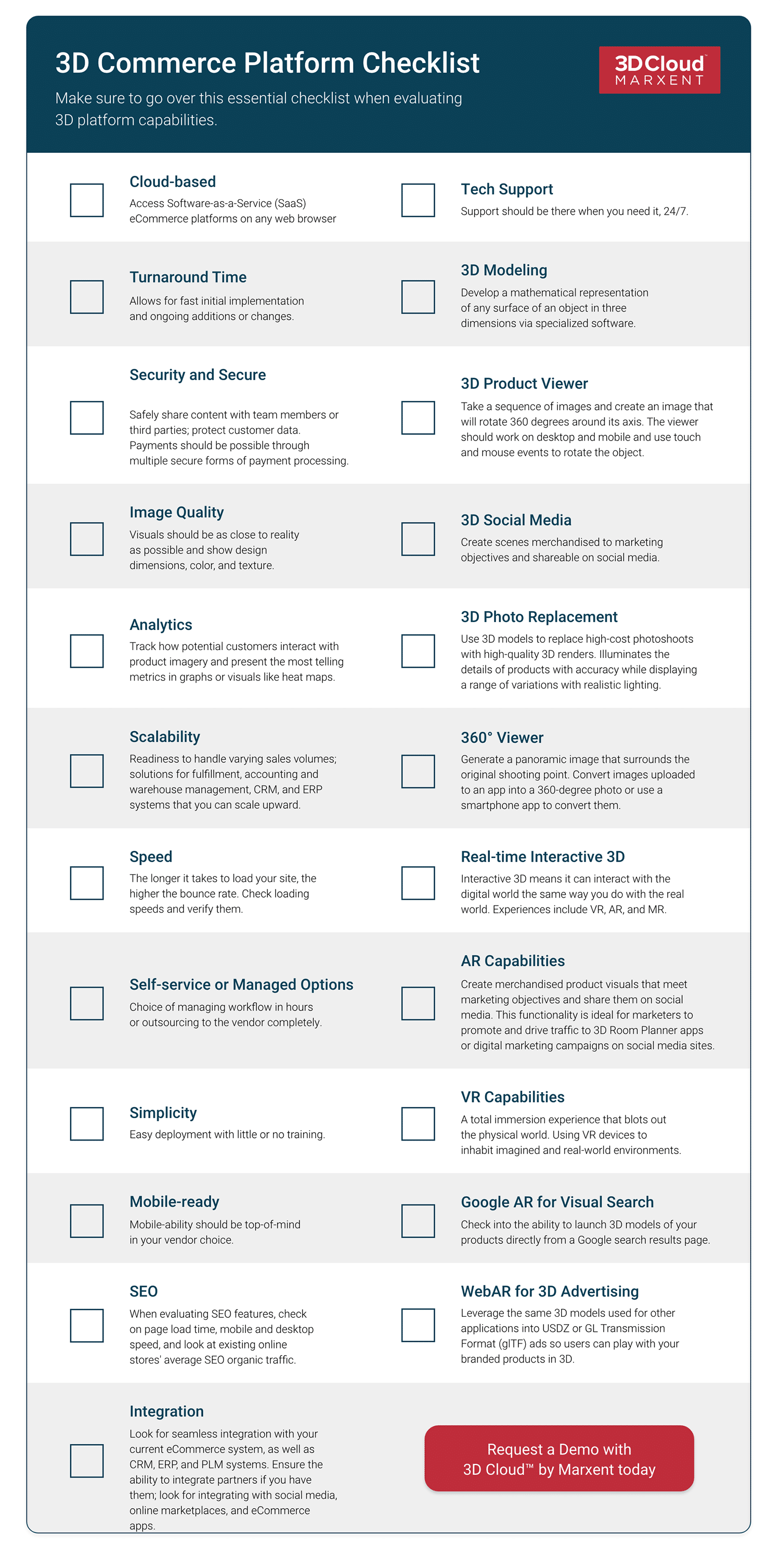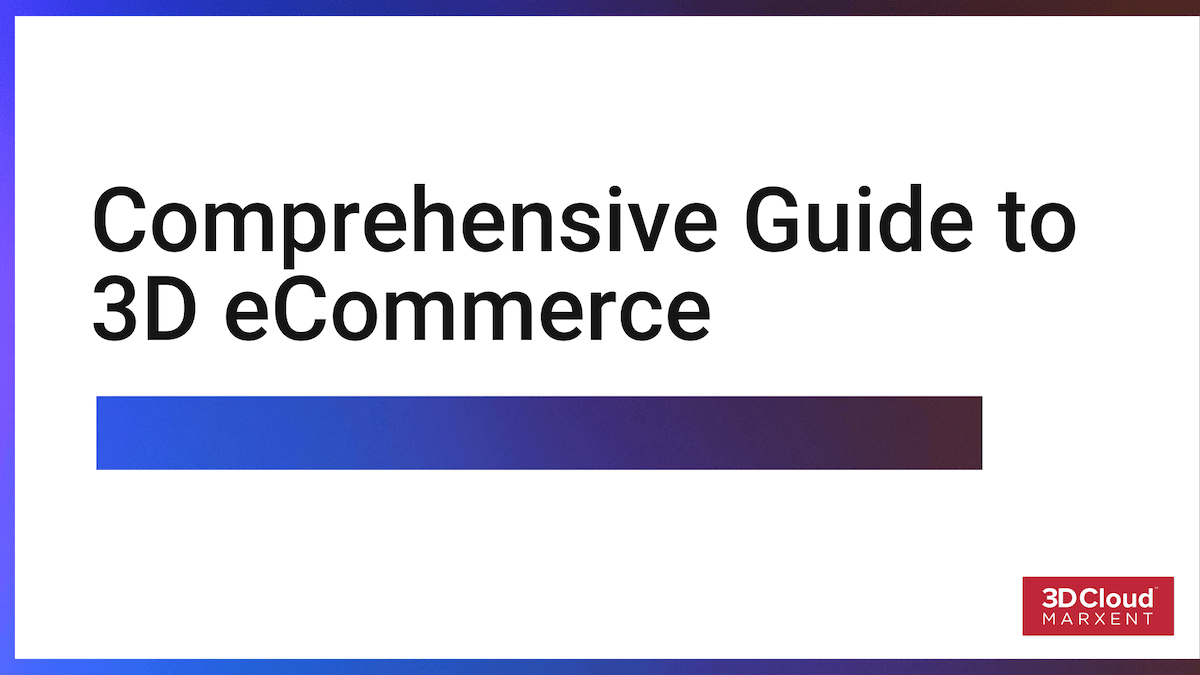
3D commerce is becoming the preferred online shopping option for people across the globe. Get the facts and stats to understand why 3D technology is a must-have to increase engagement and convert browsers into buyers.
In this article, you’ll find:
What Is 3D Commerce?
3D commerce uses embedded augmented reality (AR) and virtual reality (VR) 3D models on web pages and mobile apps. The goal is to give prospects and customers a graphic, interactive 3D product representation.
3D commerce is also known as 3D eCommerce, 3D modeling commerce, or immersive commerce. By any name, there are many reasons 3D has become a force in online retail, and they all narrow to a single focus: consumers.
“Consumers want choice and convenience. Often, they want entertainment. And in some cases, they want to feel a deep affiliation with the brand. Immersive eCommerce can bring all these effects to customers,” explains Tony Parisi, Head of AR/VR Ad Innovation for Unity Technologies, a real-time 3D development platform.
3D eCommerce offers a variety of engaging interactions for consumers, including:
- View-in-Room AR: Consumers try out furniture and décor in different configurations in realistic spaces on a 3D eCommerce website. Major furniture sellers like IKEA and Macy’s provide this tool on their websites.
- 3D Product Configurators: The potential buyer can change the colors, textures, and other features for all products from furniture to personal items like Nike running shoes or Bose headsets.
- Visual Configure, Price, and Quotes: Consumers customize almost every aspect of significant purchases like Corvette sports cars or deck design from TimberTech. The technology generates a bill of materials and final price, so customization is adjustable to fit taste and price before the final purchase.
- Virtual Try-On: Using their image, buyers can apply makeup from cosmetics companies like Revlon or Ulta. They can also try on clothing from Prada and Warby Parker eyewear – just about anything wearable.
- Computer Generated Imagery (CGI) for Photo Replacement: Building the right mood around a product using traditional production are costly and take a lot of time. With CGI, brands let consumers look at variations—setting, color, texture, uses, and more—of a particular product without drastically raising time to market or costs. Companies at every price point from Restoration Hardware to Walmart bring products to life with CGI.
How 3D Commerce Is Changing How We Shop
Many customers now pre-shop from home. That’s because 3D augmented and virtual reality offer convenience and multiple ways to view, try on, and experience items from anywhere, anytime. The result is more purchase and brand satisfaction.
5 Ways People Are Already Using 3D Commerce
What’s Involved in 3D for Commerce
3D commerce involves a mix of technology, human artistry, and technical skills. The first step is digital road mapping. That combines with 3D modeling, site integration, and data to turn product visuals into a believable reality.
6 Key Elements in the Development and Creation of a 3D eCommerce website include:
- Digital Road Mapping: A digital roadmap is a high-level planning document that describes how you plan to meet 3D commerce short- and long-term business objectives from a brand lift, refining the brand, or support for purchase intent. The roadmap identifies the scale of projects, distribution channels, and digital initiatives. The roadmap can help determine if you need to manage the creative, testing, optimization, and other functions in-house, use a technology partner, or both.
- 3D Modeling: Both AR and VR require high-quality 3D product models. The distribution method determines optimization techniques for an app or website, the model formation, and file formats. 3D models portray conceptual and real-world visuals. Models for art, entertainment, simulation, and drafting are integral to many various industries. There are four main categories of modeling:
- Wireframe: The most time-consuming modeling category, wireframes are the points, lines, and curves that describe the object’s edges and have no surfaces. Individually drawn, wireframe objects are also independently positioned.
- Surface: Surface modeling defines the edges and surfaces of a 3D object. A polygonal mesh defines the surface. The faces of the mesh are planar or two-dimensional. The mesh approximates curved surfaces, and added modeling depicts curves.
- Solid: Basic dimensional shapes, cylinders, spheres, boxes, cones, wedges, and donuts are the foundation of solid modeling. Complex solids take shape by subtraction, joining, or finding overlapping volumes. Moving a 2D object or rotating it around an axis are other ways to create a solid model.
- Reality Capture: Reality capture produces a digital 3D model of a subject, site, or building using photogrammetry—a method that extracts 3D information from photographs or by using static, mobile, and aerial laser scanning.
- Read our 3D modeling guide to learn more.
- 3D Artists and Artistry: 3D artists use their creative and technical abilities to generate photo-realistic materials, lighting, and rendered images. In VR and AR, believable 3D product models are essential for buyers seeking a realistic product exploration experience. 3D artists are computer-generated imagery (CGI) artists since that is their medium. CGI artists create special effects, environments, characters, and product renderings. Read our Q&A to discover how 3D artists work with 3D modeling.
- Site Integrations: Fast-loading 3D commerce sites are essential to a good customer experience. According to a Google study, 53% of mobile website visitors will abandon a page that takes longer than 3 seconds to load. For existing platforms, it makes sense to select a provider that has a current plug-in or app for that platform. Appropriate, scalable integration of AR and VR is vital, so pages load fast to avoid customer experience disruptions.
- 3D Secure eCommerce: An essential measure in site integrations is 3D Secure (3DS). They add extra eCommerce security to protect merchants against fraudulent purchases on their sites. Think of “3D” as three-dimensional version that consists of three domains–the card holder’s bank, the acquirer, and the card scheme. They all play a critical role in security.
- Product Benchmarking: Start with a practical number of products that already have existing performance data and benchmark against those. A/B testing that uses different variables can improve user flows and a variety of functionalities. The results are helpful for making site improvements and optimizing user engagement.
- Data Capture and Analysis: Understanding what works and needs improvement in any eCommerce site is vital to remain relevant and profitable. Data around 3D and AR interactions are countless, so be sure to include data capture and analysis. Data capture and analysis measure engagement by category and product over time, repeat visits, customer service costs, conversion over time, and more. One of the most important benefits of data capture and analysis is to overcome one of the biggest problems for eCommerce companies–high return rates.
Measuring the Effects of 3D Ecommerce
Measuring the effects of a 3D eCommerce site helps make the most of a large investment. There are data and analysis options to pinpoint how the experience influences your buyer’s behavior.
Analytics Tools for 3D Commerce
Analytics tools for 3D commerce move your sales and marketing efforts forward faster. Market analysis tools include Google Analytics, AI analytics, embedded and social media analytics.
Analytic tool options include:
- Google Analytics: Google Analytics and Google’s Enhanced eCommerce Analytics are free. The tools serve up metrics at every stage of sales, like where traffic originates (mobile, tablet, or desktop), product performance, and conversion rates. For about $150k per year, Google Analytics 360 offers comprehensive audit functions, almost 100% accuracy, and data refresh within four hours. This paid version includes data-driven attribution modeling to evaluate online customer behavior.
- Artificial Intelligence Analytics: Machine learning collects data in real-time and applies it to user data enrichment, user identification across devices, intelligent ad personalization, and predictive analytics. AI uses natural language processing to contextualize and improve search results. Visual search functionality also improve product matches.
- Embedded Analytics:Some eCommerce platforms have integrated analytics in the backend as part of their solution, providing insights almost instantly.
- Social Media Analytics: Depending on the eCommerce platform, you can connect your online store to your social media pages like Facebook and Instagram and track the data for further analysis.
What should you measure to understand your customer’s behaviors and buying patterns? Here are some metrics to consider:
- Category Metrics: Understanding how a consumer engages by category and over time is fundamental to sales success. Other metrics to monitor are visitor repeat behavior, ad performance for retargeting, and the cost of customer service pre-sale. Use this data to evaluate products, promote return visits, and consider category alternatives to offer new or returning customers.
- Qualified Sales Metrics: These metrics can point the way to upsell opportunities to buyers who place orders after they’ve done their research and made a purchase. You can use these metrics to evaluate conversion over time, per visit revenue, the size of average orders, and acquisition costs. This information can help you understand a qualified buyer’s persona.
- Post–purchase Metrics: Data gathered after a purchase is proof that you’re doing things right and highlights where to make improvements. Tracking metrics like rate of return, customer support costs after the sale, buyer satisfaction rates, and the content of customer reviews provide valuable intelligence about brand perceptions.
Analyzing and measuring 3D eCommerce success offers the opportunity to refine product offerings and enrich the customer experience.
Types of 3D Commerce
Different types of 3D commerce visuals embedded on website pages and mobile apps provide access to 3D visualizations and 360-degree rotations. Users also enjoy viewing real-time interactive 3D, AR, and VR.
Visual eCommerce has changed customer requirements about online shopping. Customers can surf and interact with items on mobile devices by using their fingers to touch, swipe, or drag across the touchscreens. Some retailers also deploy VR and AR applications in their physical stores to provide customers information on products, virtual try out or try on, and the ability to explore products or categories.
3D Visualization 3D Commerce
3D visualization gives customers an opportunity to see products in realistic spaces. Items appear in context. So they can see product colors, textures, scale, and placement. Viewing in 3D makes it easy for potential customers to know what they are buying.
3D visualization is helpful for more expensive items like a home or office furnishings, exterior home improvement products, and appliances that need to fit into a specific space and meet aesthetic requirements.
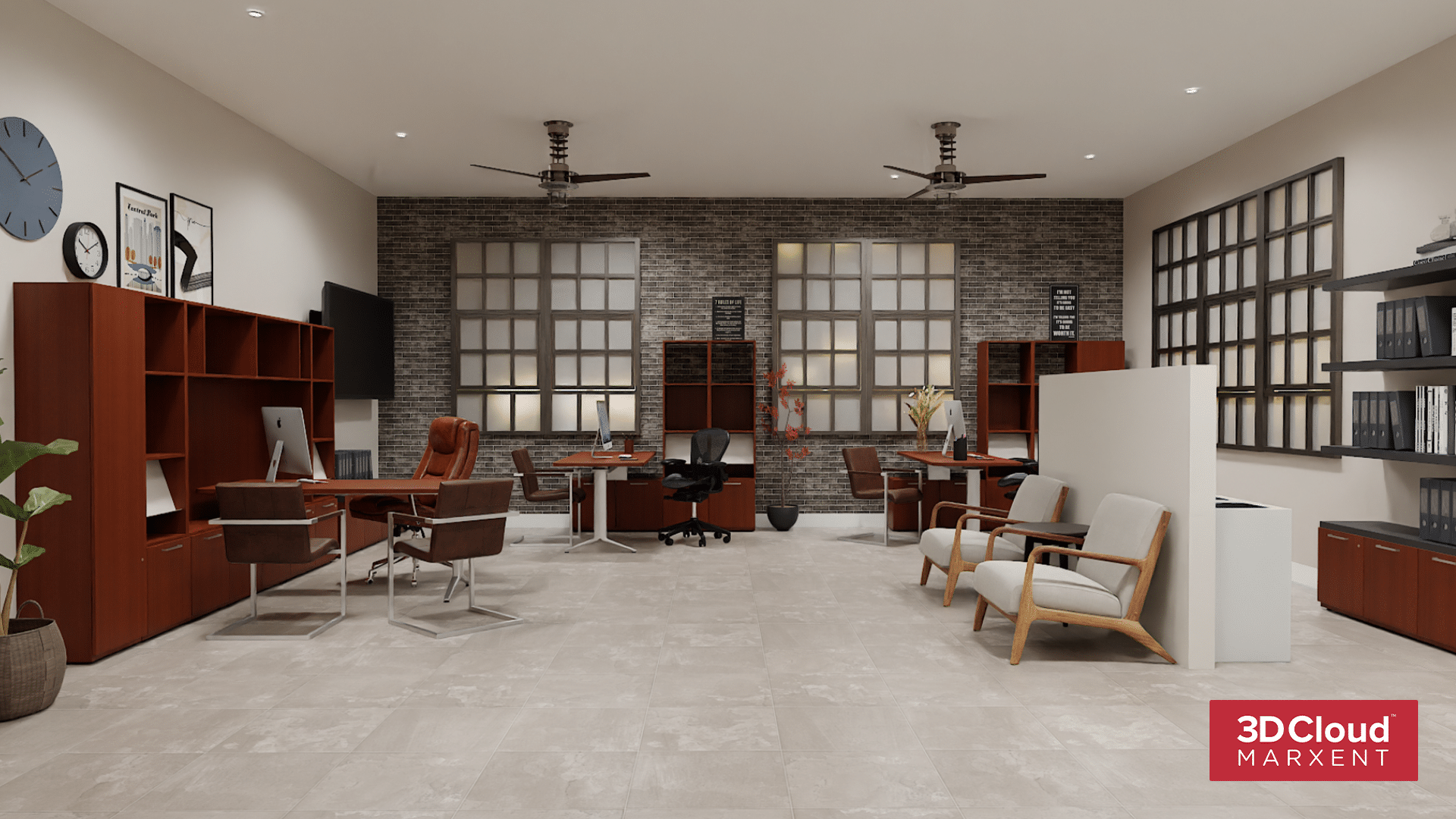
Office Rendering 3D Cloud by Marxent 3D Office Planner with Design from Photo
360-Degree Rotations and Spins in 3D Commerce
360-degree rotations and spins in 3D commerce give customers the ability to examine product details in real-time. The result is fewer product returns and higher conversions.
The ability to see items in hyper-detail, and have the ability to rotate and zoom in and out, gives buyers of high-ticket items like electronics, high-priced jewelry, cars, and homes more purchasing confidence and a higher propensity to buy.
3D Cloud by Marxent 3D Product Configurator for eCommerce
Real-time Interactive 3D Accuracy for 3D Commerce
Interactive 3D gives consumers entrée into the digital world and a way to interact within it as you would in the real world. Experiences range from dynamic web experiences to fully immersive VR/AR/or Mixed Reality (MR) experiences.
MR combines the physical and virtual worlds. This technology is an excellent tool for selling complex items like sports cars with custom features, products requiring assembly, or goods that generally come with an owner’s manual for customer self-service.
What Is Mixed Reality? | 3D Cloud
Augmented Reality for 3D Commerce
Augmented reality for 3D commerce shows real-world objects enhanced by computer-generated perceptions. The senses brought into play can include sight, sound, touch, sensation, and even smell.
AR provides contextual information about products. You just have a computer or mobile device to experience the technology. AR requires less equipment than VR, making it more accessible. According to an eMarketer report, 35% of U.S. respondents said they had used AR to visualize vehicle or furniture customizations as of June 2020.
3D Cloud WebAR and Augmented Reality Furniture Solutions
Virtual Reality for 3D Commerce
Virtual reality for 3D Commerce involves donning a head-mounted display and tracking device. Surround sound adds to the experience. Users can interact with a computer-generated environment in VR.
VR equipment manufacturers are in a race to refine less expensive, lighter, and more accessible devices. Right now, VR virtual showroom access is both in-store or via devices. Customers can browse through clothing racks, touch and feel all kinds of products, and meet with friends in real-time for a joint shopping experience. VR is a profoundly brand-building shopping experience.
3D Cloud Virtual Reality Shopping Apps for Retailers
Why 3D Technology Is a Must-Have for eCommerce
3D technology is a must-have for eCommerce because it delivers interactive images customers want. These experiences increase sales and improve customer satisfaction and brand loyalty.
As brick-and-mortar locations reopen post-pandemic, the customers they serve will have buying habits informed by their eCommerce experience. Consumers have learned to understand products without being able to touch them. Thus, they expect brands to create shopping experiences that are entertaining and informative.
Even pre-pandemic, Omnisend’s Omnichannel Marketing Automation Statistics 2019 report found that customers who interact with omnichannel campaigns engage and purchase more often. That same study shows that omnichannel campaigns improve eCommerce customer retention and attracts those who spend more when they make a purchase.
Shawn Rothery, Director of 3D Content for 3D Cloud, says, “There’s no question that the next generation of eCommerce is 3D. First, there was the internet, then mobile shopping—now it’s 3D everywhere.”
 Unity’s Parisi adds that increasing realism increases a customer’s satisfaction, even before they buy. “The more intuitive and real-world the interaction and the more it enables product exploration from all angles, the more it builds a high confidence in purchasing choices,” declares Parisi. “And nothing can provide a high production value entertainment experience like real-time 3D graphics.”
Unity’s Parisi adds that increasing realism increases a customer’s satisfaction, even before they buy. “The more intuitive and real-world the interaction and the more it enables product exploration from all angles, the more it builds a high confidence in purchasing choices,” declares Parisi. “And nothing can provide a high production value entertainment experience like real-time 3D graphics.”
IBMs 2020 U.S. Retail Index report found that the pandemic accelerated the shift to digital shopping by five years to meet and engage with customers at their location.
Here’s are some reasons why 3D commerce is a consumer preference:
- Low Touch Shopping: The pandemic made low touch buying a plus, which is likely to be a preference in the future. Trying on clothing, cosmetics, jewelry, glasses, shoes, and other personal items virtually online or in-store makes hygiene-aware consumers more comfortable.
- Easier Search and Comparison: The ability to search by personal preferences or to have options served up simplifies and personalizes shopping.
- Mobile Matters: As the world goes increasingly mobile, having items literally at hand and realistically portrayed offers the ultimate convenience.
- Comparison Shopping: Sizing up one item’s features against another is much easier to understand with 3D. Once selected, customers can more easily search for similar items at different price points.
- Try Out and Try On: For wearables or items that need to fit a particular dimension, virtually trying things on for size makes buying decisions easier and reduces returns.
- Engaging Customer Experience: Whether it’s to ensure the fit of apparel or determine the “in place” fit of furniture or appliances in the home, AR and VR work well for customers who want to see products before they buy and have an enjoyable experience the same time.
- Deeper Brand Experience: Mixed commerce or interacting with products online and in-store gives consumers a more profound sense of brand allegiance.
- Time and Stress Savings: Being able to virtually inspect a vast number of items without traveling to a brick-and-mortar shop saves time and money.
The 2019 SAP/eCommerce Foundation USA eCommerce Report found that highly engaged consumers spend 60% more per transaction and buy 90% more frequently. That’s why mega-retailers like Amazon, Walmart, Target, and apparel companies like Nordstrom, H&M, and Nike use AR and VR as a cornerstone of their overall marketing strategy. Early entries in 3D commerce include furniture retailers La-Z-Boy and Ashley, cabinetry firms American Woodmark, and kitchen and bath products manufacturers Robern and Kohler.
Benefits of 3D Commerce
The benefits of 3D commerce for product sellers are robust and interrelated. Benefits include lower inventory needs and fewer returns. 3D commerce typically results in more sales conversions and more upsell and cross-sell opportunities.
- Contactless Shopping Experience: What’s good for the consumer is good for the seller. Consumers who are now reluctant to touch products on shelves, try on clothes, sit on the furniture, or even tap on the checkout payment screens can browse or shop using devices.
- Customer Confidence: In some luxury categories like jewelry and watches, customers must be confident that they’re getting what they want. Overall, online jewelry and watch sales have leaped in the last five years, while higher-end items have seen more modest increases. 3D visuals can help retailers in high-priced categories because customers can take their time, inspect items in detail, and comparison shop.
- Transformed In-store Experience: Consumers can use their mobile devices to view 3D product information or interact with in-store kiosks. They can make product selections and buy while skipping the checkout counter.
- Attract More Customers: People like the fun and engagement offered by 3D shopping. 63% of U.S. consumers claim their shopping experience would improve with AR, according to data from ecomdash.
- Improve Conversion Rates: 3D technology drives an increase in sales/conversions over traditional methods–sometimes over 40%, according to Cappasity research. Increased sales can help cover the costs of adding 3D eCommerce to a website.
- Less Costly and Time-Consuming: Building a 3D image library is easier, faster, and more affordable than traditional photoshoots. According to SAP’s 2019 Global Ecommerce Foundation Report, digital product visualization is about 10% of the cost of conventional photography.
- Keep Pace with Competitors and Big Retail: 3D product images bring the shopping experience to a new level that exceeds consumer expectations, which is why top retailers and online malls provide them. Without a 3D strategy, retailers risk falling behind the competition and losing customers.
- 3D Imagery Expedites Sales Times: The correct visual presentation can do the work of knowledgeable sales associates and save money on brick-and-mortar personnel. Consumers also value the ability to comparison shop—something they can easily do online, which quickly narrows down choices for a faster sale, ultimately.
- Fewer Returns: Usually, high return rates are an issue in eCommerce because the product looks different in person than on the seller’s website. With high-quality images, consumers can manipulate and evaluate products based on real-life specs, eliminating that problem, and preventing returns.
- More Ways and Opportunities to Upsell and Cross-sell: Tracking customer browsing and buying patterns gives you the information you need for upsells and cross-selling based on known customer preferences.
- Less Stress for Big Ticket Item Purveyors: Brands can quickly change big-ticket product models to match emerging customer demands with 3D visuals. The use of CGI to reconfigure products means that fewer items need to be on hand and made to order.
An excellent example of how 3D helps sales is the results from L’Oreal eCommerce. According to Retail Touchpoints, even pre-pandemic, sales were up by 49%, which could be a result of the try before you buy enabled by AR.
Tips for Getting Started with 3D Commerce
Essential tips for getting started with 3D include having a sizable budget and a clear vision. You’ll also want to start with products that will benefit most from 3D models. Remember that 3D commerce positively impacts brands and sales.
Basic tips to consider as you consider adding 3D commerce:
- Gear Up to Invest: Transforming your online shopping website will take a significant financial investment in new technology, staff, and technology partners.
- Identify Key Products: Decide which products need 3D visualization to attract customers. Save the others for another time or limit the products you display in AR or VR to reduce expenses.
- Keep Customers Top of Mind:It’s important communicate with customers how they want. Use expectations, buyer demands, and opportunities associated with immersive 3D interactions to elevate their buying journey and ensure conversion and loyalty.
- Take It Slow: Make a trial run with one item or product line—test and track results.
- Create 3D Models: If your company is already using 3D, find ways to leverage those technologies. If you don’t already have 3D models, start scanning your products, or have employ a team of 3D artists to create digital twins. In general, scanning is better for products that are small, matte, and opaque. 3D artists are a better choice for creating the models of larger goods like furniture and cars.
- Optimize Models: Now that you have your 3D models, ensure product images are in the correct format and compressed. They load quickly but without sacrificing quality— an artist or an automated solution to complete file reductions.
- Deploy: The next step is to embed your models on your website. Wrap up the final measure in-house, and be mindful of Khronos standards or use a vendor.
Khronos 3D Commerce
The non-profit, 170 member Khronos 3D Commerce™ Working Group spearheads industry alignment on the creation, management, and display of 3D content for eCommerce. Since the group’s formation, the use cases for 3D assets in eCommerce have expanded rapidly.
Khronos’ open standards and associated tests enable software applications and middleware to effectively control authoring and faster playback of dynamic media across a wide variety of platforms and devices, including file format standards. The Khronos Group developed the GLB and glTF formats, which 3D Cloud supports along with other file formats.
Industry-Wide 3D Ecommerce Modeling Software Standards and Guidelines
The Khronos guidelines contain best practices and modeling standards. Artists use these to streamline creating 3D models for real-time rendering on multiple delivery platforms. The goal is to provide high-quality 3D assets, AR and VR, product configurators, and interactive 3D marketing tools.
The Realtime Asset Creation Guidelines best practices include standards on coordinating of systems and scale, file formats and asset structure, geometry, lighting and rendering, materials and textures, publishing targets, and techniques for mapping textures onto 3D assets.
3D Commerce by the Numbers
3D commerce by the numbers reveals growth in the number of people who shop with 3D technology and prefer it. The pandemic moved people online in 2020 and 2021, which has likely rewritten shopping rules into the future.
5G and its impact on eCommerce is just beginning and it will likely help improve how customers view 3D eCommerce on mobile devices. With speeds up to 100 times faster than 4G, AR and VR experiences will be smoother. For some, if not all users, the technology banishes frustrating lags and buffering and provides continuous VR experiences. 5G enriches VR content quality and enhances artificial intelligence (AI) learning capabilities.
According to the Pew Research Center, U.S. 85% of the U.S. population owns a smartphone. Worldwide, m-commerce makes up almost 75% of all e-commerce sales. Of those sales, it’s expected that $120 billion were AR-driven.
Based on those statistics, an eCommerce business needs to keep mobile in mind and ensure that 3D m-commerce is enabled, particularly for millennials and Gen Xers who spend up to 56 days a year on their phones. Thanks to 5G, those numbers will almost certainly climb in the future.
In January 2021, Digital Commerce 360 reported that eCommerce sales accounted for 101% of all retail gains in 2020. According to the Harvard Business Review, as more people turned to eCommerce during COVID, AR became essential for online retailers. For example, retailers who leveraged AR experienced a 19% increase in customer engagement and a 90% spike in customer conversions, according to a report by Retail Customer Experience, 2020.
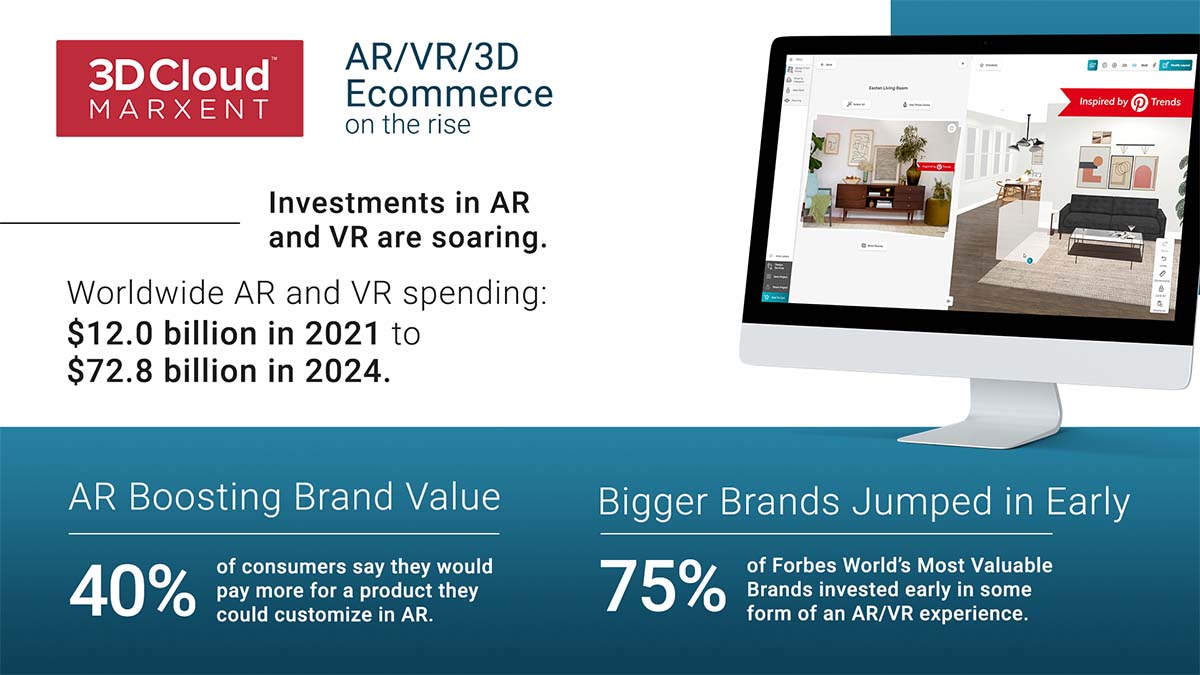
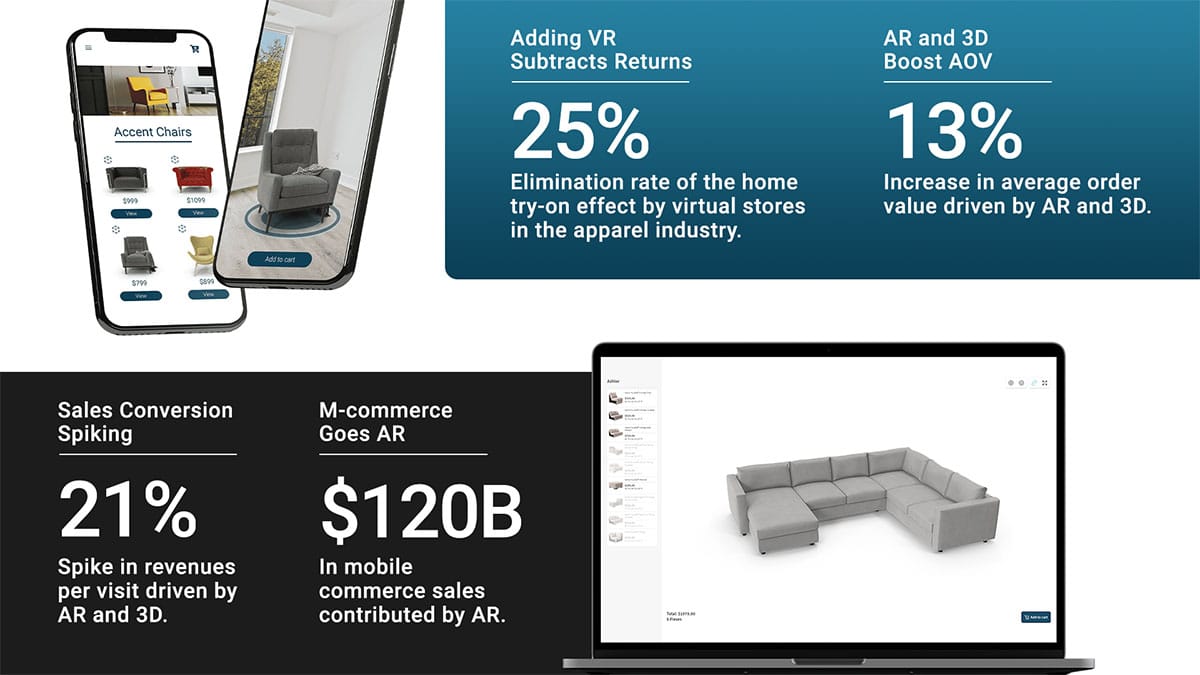
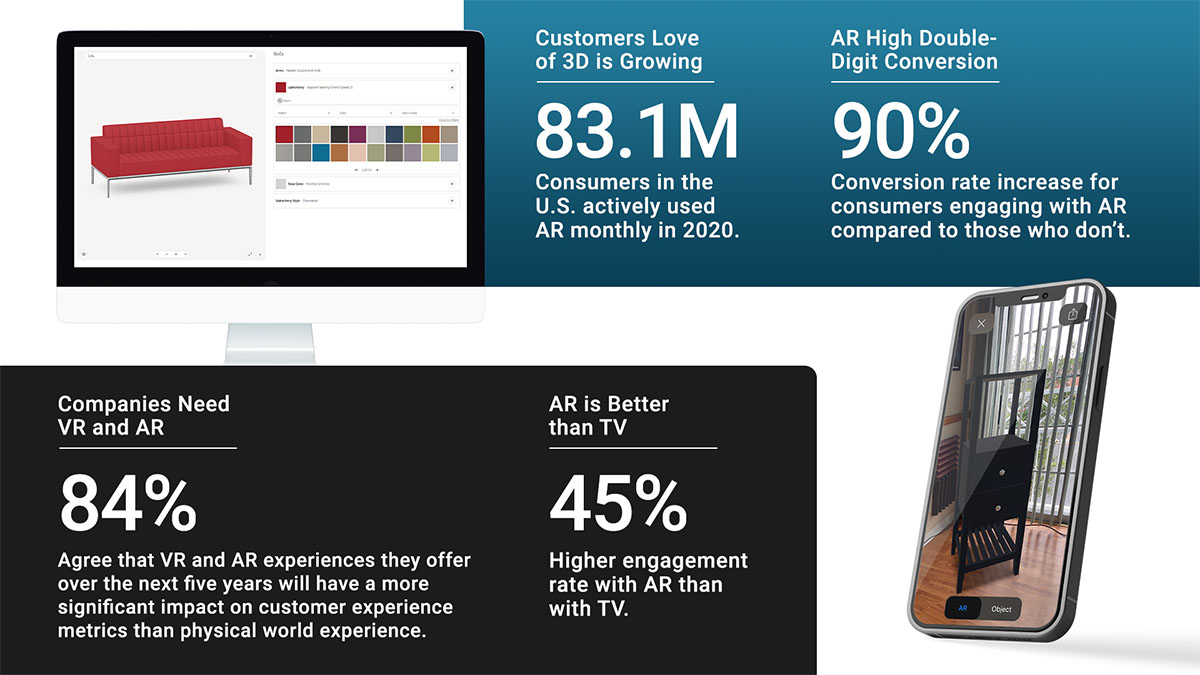
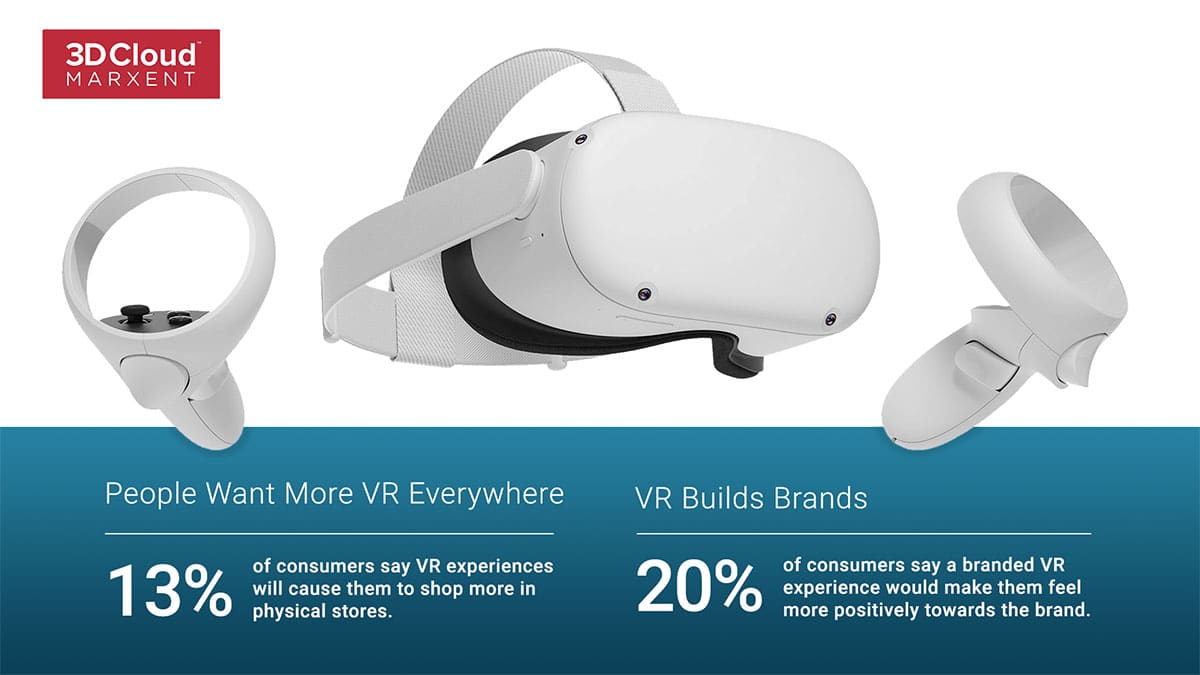
3D eCommerce Stores
3D eCommerce stores, or virtual stores, take brick-and-mortar browsing and turns it into a digital experience. Online store simulates real-life exploration that can happen anytime, anyplace.
Virtual reality technologies bring new features to online shopping. Visualizing and comparing goods is more accessible than ever. Consumers can now review and configure products in 3D, zoom in and out from various angles to assess the quality of your products, display information, and make purchases in real-time.
The U.S. Chamber of Commerce notes that with stores shut during COVID, retailers embraced virtual stores. Some brands may prefer a virtual reality store where consumers can use their own VR headsets. Outside of using VR, brands can offer customers access to virtual shops through their mobile app or website. In some cases, brands will design an app to create a 3D store that resembles their flagship retail store. In other instances, brands will transform their physical retail experience into a virtual one and offer real-time interaction with sales associates.
The Future of 3D Commerce from the Experts
The future of 3D commerce is about experimentation. It offers new avenues for building consumer relationships, branding, and interactive experiences that pack a visual punch. Companies will continue to refine the process based on data and new technologies.
Tony Parisi of Unity and Shawn Rothery of 3D Cloud weigh in on near-term experimentation, innovation, and the role brick and mortar will continue to play in immersive commerce.
Future Opportunities in 3D Commerce:
- Experimentation and Content Creation: “In the near term, there will be experimentation around content creation, that is, how to create models of physical products so that we can represent them virtually for use in online catalogs, mobile AR, and virtual showrooms” predicts Parisi. “For years, 3D content creation was the province of game developers and visual effects experts. But now, every marketer and online catalog manager will need to create and deliver 3D interactive models so consumers can experience products virtually before they buy. This activity is going to need to scale up fast and be usable by a range of content creators.”
- Innovation in Imaging Solutions:“There are various imaging solutions in play, including photogrammetry, scanning, converting CAD models, and creating models by hand. They all have trade-offs,” Parisi notes. “Expect to see significant innovation in this area over the next five years. I love what 3D Cloud is doing in this realm because, for many use cases, their platform can procedurally generate 3D models from product data, allowing for infinite variations and great scalability of content production.”
- Enhancing the Physical World with Computer Vision (CV):CV is the field of study that develops and explores techniques to help computers see and understand the content of digital images such as photographs and videos. “CV not only recognizes the environment around you so you can place products for viewing—critical for great AR—but also recognizes images and objects, which enhances the physical world with additional information,” explains Parisi. “For example, with certain AR-enabled apps, you can point your phone’s camera at product packaging and reveal additional information about the product or launch entertaining companion content. In the not-too-distant future, this capability will be built into your phone (or some nifty new smart glasses) for pretty much anything and everything in the physical world, not just specific retail products.”
- The Role of Brick and Mortar:Physical stores do have a future, according to Parisi. “Nothing will ever replace the ability to physically experience products or the personal touch of interacting in the real world with a retail professional,” stresses Parisi. “Yes, brick-and-mortar are having a tough time at the moment, but we’re starting to see immersive technology employed to enhance the in-store experience. That should increase retailers’ chances of survival. Here are some examples of what’s just ahead: AR used to add detailed product information in a virtual space and transforming merchandising into a highly entertaining experience. We’ll also see the use of VR for virtual tours or activities like home planning with the help of an in-store expert. AR and VR will also offer many more items via kiosks or displays than could ever be stocked physically to expand customer choice.”
Future Challenges in 3D Commerce:
- Pipeline Integration:“Our next big step is full integration with digital merchant pipelines,” 3D Cloud’s Rothery explains. “For example, Amazon AR: How do we make our content interact with them directly? Our guiding principle with 3D content is Make once and reuse everywhere, and that’s the way we are approaching integration issues. 3D Cloud is built for flexibility and adjusts quickly to support the needs of our partners.”
- Digital Twining:“Companies need to have a strategy right now to create digital twins (3D representations) of everything in their product catalog,” says Parisi. “That’s a big ask, but at some point, that kind of content creation will become commonplace, as ubiquitous as photography. If retailers don’t do it, they will be left behind.”
- Brand Storytelling:“Companies need to envision how a virtual and augmented world affects how they market and sell their products,” advises Parisi. “Beyond the basic 3D representation of the product, how do you tell your brand story with VR and AR? And how do you provide easy ways for consumers to discover, explore, and try your products in ways that improve the experience of today’s world? The world, where digital technology has made buying easy but, in some ways, left the fun of shopping behind?”
- Ongoing Complexity: “The significant remaining barrier to truly having 3D everywhere is the cost and complexity of generating 3D content,” says Rothery. “We’ve overcome other barriers: orchestrating ordering and generation, QA of assets, obligations to multiple platforms, and establishing reasonable standards. We’re already supporting multiple standards, not just file formats like USDZ, FBX, or OBJ–but other 3D content platforms, like Wayfair and Amazon.”
How to Choose a Quality 3D eCommerce Visualization Platform
Choosing a 3D eCommerce visualization platform rest on two things. First is your needs assessment. Second are the technical capabilities and features available from various vendors.
3D Cloud’s Rothery says as 3D eCommerce requirements have become more exacting, the bar goes up on the definition of quality. “Realism and speed are what denote quality right now,” Rothery stresses. “We’ve traditionally had a sliding scale between speed and quality—the faster the models loaded, the lower the quality. Now we need both.”
Other considerations have taken on more importance. Rothery adds, “The shape and size of the actual item must be an exact match to the 3D product. The merchants want it to be exact. Also, models must be performant—they must render as close to instantly as possible—no downloading over time, even a few seconds.”
Rothery uses the work 3D Cloud does for furniture manufacturers as an example. “There are two main considerations: first, the piece of furniture must be the same size and shape as the real-life counterpart—the scale and accuracy must be correct. Second, the materials (upholstery, leathers, woods) must look as realistic as possible, matching the real-world texture of the object.”
3D eCommerce Self-Assessment
A 3D eCommerce self-assessment should consider the type of products you sell, competitors, and your budget. A look at your overall business and place in the industry can help you decide if now is the right time to change your visual strategy.
As part of your 3D eCommerce self-assessment, ask:
- Do you sell a product that customers need to see multidimensionally to understand?
Companies that sell products are often good candidates for 3D commerce. If you are in a service business, the return on your investment may not be high enough to merit the cost of investing in an eCommerce platform and imagery. - Is 3D commerce a cost of entry in your business?
If you sell high ticket, wearable, or highly customizable products and your competitors have 3D eCommerce sites, it may be time to shift to higher quality visuals. - Is 2D holding your business back?
If you have a high percentage of returns, it may be time to move past static 2d images. Boost customer’s product education and engagement before they hit the buy button.
If you decide to move forward into eCommerce, the next step is to evaluate 3D platform capabilities. Be sure to ask for customer referrals from potential vendors and do some comparison shopping before selecting a 3D eCommerce partner.
3D Cloud’s 3D Commerce Cloud Platform Drives Sales
Companies that want to thrive in the competitive retail landscape know they need to provide high-quality 3D experiences to customers. They also know acquiring that expertise in-house isn’t easy. 3D cloud provides compelling 3D models that drive sales and retain customers.
Top furniture retailers use 3D Cloud-powered 3D product visualization apps to boost sales, reduce returns, and offer the 3D Room Planner with Design from Photo.
Image is Everything: The 3D Cloud 3D Room Planner with Design from Photo
The patented-protected Design from Photo technology process allows consumers to build their ultimate dream environments—without a learning curve or browsing through large catalogs.
Home brands grow engagement and sales
Design from Photo begins when the customer browses inspirational photos from sources like Pinterest or another online image search tool. Once found, the picture is the basis for an intuitive, self-service design experience. The entire room designed by the shopper goes straight to an eCommerce cart, or they can share it with a design pro for collaboration.
Lowe’s Home Improvement, Macy’s, La-Z-Boy, John Lewis & Partners, American Furniture Warehouse, and American Woodmark use the 3D Cloud Platform and 3D Room Planner with Design from Photo, which leads the way to online engagement and growth.
Design from Photo is easy to learn. Request a demo to see it in action and how it can help transform your business.

